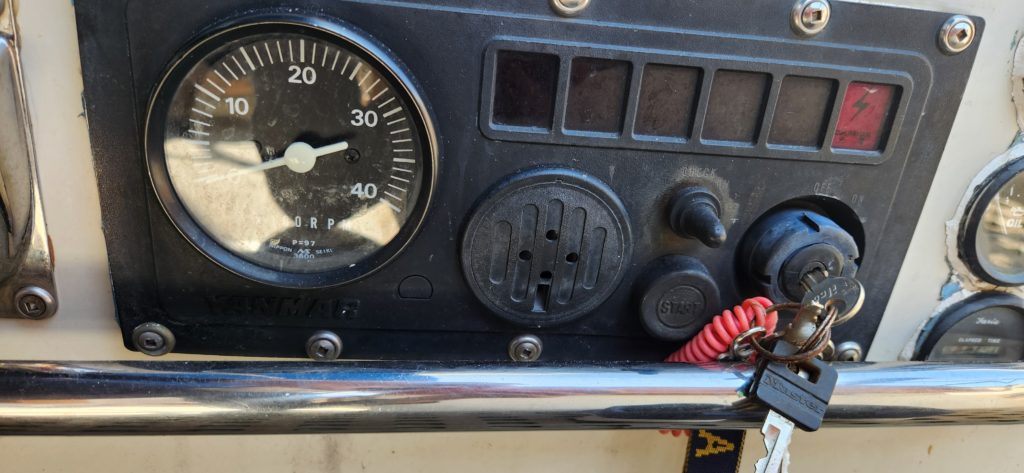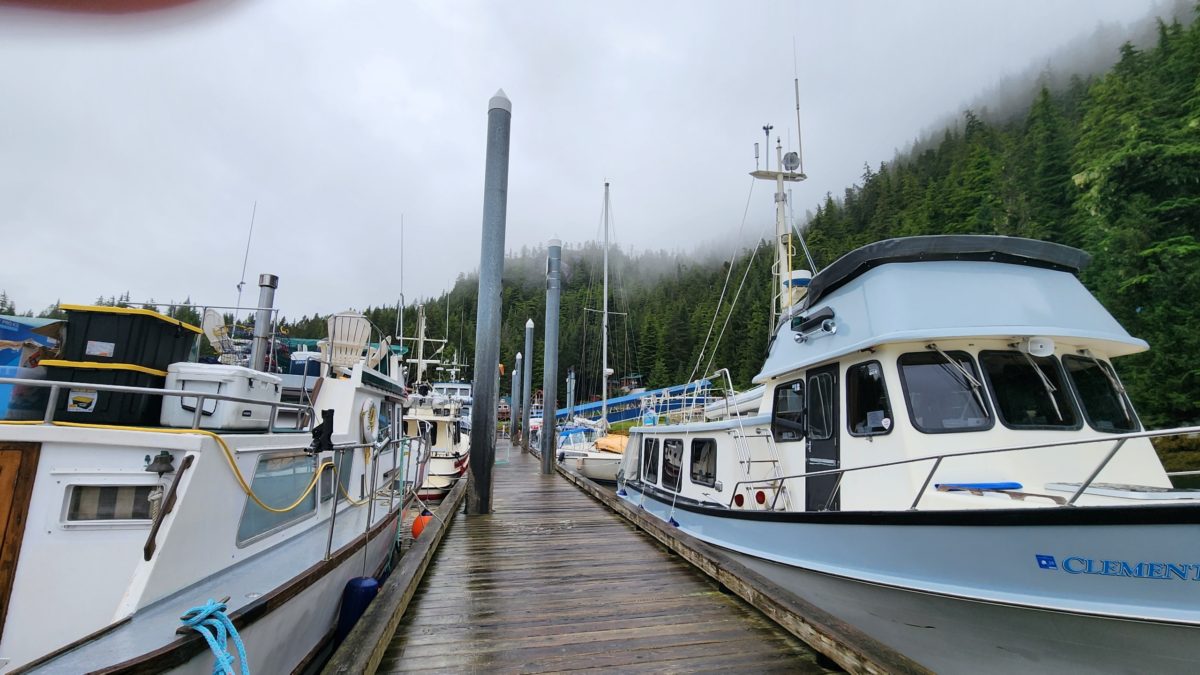Chapin Bay, AK 29-JUL-2024 – We spent the last two days in Baranof Warm Springs. We’ve been there before. The town is the same, but feels spiffier, better kept and more prosperous. We knew that people generally leave the dock around 11, so we should be there around 11 to 11:30. We spent the previous night about six miles north.
The tidal current charts have been very unreliable. Navionics and OpenCPN differ by more than an hour and the speed of the current don’t agree at all. We picked up a faster current than expected and arrived about 10:30 to a completely full, not empty, dock, we thought. Jennifer had determined that we would raft up, so I was prepared with fenders on both sides and lines on the starboard side. As we got close to the dock, we could see there was space on the inside. We weren’t sure how much, but as we got in it was about 40’. Enough for Jennifer to turn us around and dock on the starboard side. The current pushed us off the dock, but Jennifer repositioned and we docked the first try.
This was new. The boats that were docked there had already left; the new boats were docked. We were lucky to grab this spot.
We’ve noticed, this trip in South East Alaska, that there are very many fewer sailboats, more power boats and many more crewed charter boats. We also, so far, have yet to anchor anywhere alone.
Only small things have been breaking, and they have been easily fixed:
- The bolts holding the mainsheet traveler on the starboard side backed out a goodly distance. I have no idea how long this took. It has been six years since I’ve looked at them.
- The ventilator in the hanging locker has been leaking rain into the closet. I don’t know why it didn’t occur to me that this was the problem. The washer around the fan shaft had atrophied. I replaced it with Bed-It Butyl Rubber and (so far) it doesn’t leak.

- The engine panel stopped sounding the alarm when we turned on the key. It did this for the first time after we fueled in Hoona. This took some thinking about. Only one light came on instead of… how many? I didn’t know. I didn’t know how many lights there were and how many come on. I figured out how the panel worked and that the alternator light came on and so did the oil pressure light. The coolant water over temperature light did not. That made sense, the alternator wasn’t turning and neither was the oil pump, those lights should come on, water temperature shouldn’t. The temperature gauge still worked and so did the oil pressure gauge. I thought that pointed to the panel. I traced everything back and figured if the bulb blew out, the alarm wouldn’t sound: a blown bulb. I sat and thought about the electronics that would turn on a light when the sending unit for the gauge was low. Pretty sophisticated. Wait, no. The gauges had nothing to do with the panel: completely separate wiring. There is a sending unit for the light and one for the gauge. Bingo. The wire for the light’s sending unit was broken and inspecting it proved to be true. The connector broke, but the nut that held it on didn’t move easily. I decided not to mess with it. The light has never come on; I check the oil EVERY time we start the engine.
- Anchor light stopped working two different times. The first time a solder connection failed; the second time the wire to the plug socket in the cockpit table became disconnected.
I’m not a hero, but I’m keeping up with things.
The first part of this trip was a rush to get south. We did overnights to make time (and to cross the Gulf of Alaska). We spent time in a place only as necessary to avoid weather and make repairs. In South Central, we anchored alone and enjoyed the aloneness. Last night (30-JUL-2024) and tonight we’re in Stedman Cove, the north end of Rocky Pass, and are, for the first time since we entered South East, we’ve anchored alone.
The change in the number of boats and the type of boats encourages us to think about what we are doing and our expectations. The increase in the number of boats is somewhat the COVID effect: Lots of people bought boats. But it is also a technology effect: Starlink. With Starlink, we all have full internet all the time, if we’d like it. Remote workers can be anywhere, including the wilds of Alaska working on a boat in a cove, or while underway. Five years ago, it was rare to see younger families because very few people could get ten weeks off to get up to Glacier Bay. That’s no longer necessary.
We see Starlink on almost every boat. In small towns, like Elfin cove, every house has it outside the window. The cost is cheap enough that no one seems to be sharing the cost. This is a sea change in communications.
Established towns are growing: Homer gets private jets now and the communities around it are mushrooming with huge houses on the ridges. Harbors and marinas are expanding. The money we see in Port Townsend is still looking for a place to go: Hollowing out of the middle class? I can’t tell. Am I still middle class?
Yes, I must be. We just do things on zero money, while looking very cool. I mean this.
The effect of marketing, the great evil, can not be overestimated. We rarely see vessels under forty feet now, and those that are, are forty years old and more. At Baranof Warm Springs, the boats on the dock were all over forty feet and power boats.*
The push is ever bigger.
The number of charter boats seems to have also blossomed. 90+ footers look like the norm. They can only carry twelve passengers, no matter how big they are, they become ‘‘inspected’’ vessels after that. †
They used to rent for $10K per week, but when we spoke to Eric, captain of 85-foot charter boat, the numbers seemed less, but then the luxury he was offering was less as well (crew/passenger ratio, food, etc.).
When I started this, I said I wanted to do ten years – I envisioned a very different ten years, but ten years it was. This is year eleven. Are we starting to hit our limit?
When we started this, I watched YouTube channels, read blogs, and first-person sailing accounts by the dozen. The channels I watched have changed, the people all have kids now and James, and others, are selling their boats and swallowing the anchor.
We’ll have Caro Babbo in Puget Sound this winter and next summer and the following winter. We spoke about taking her down to Mexico, cruising Baja. That’s not sounding so enticing right now. I thought we might take her there and then through the canal… then do my original voyage. I’m a little at loose ends. Is it the stroke?
When I look at what I want to do, nothing is that appealing. I still have to deal with my brother and my parents’ house – he is the executor and has not released it from the estate after five years – and other tasks, but nothing that really grabs me. I know what we’re doing for the next year, so that time is pretty full. I also realize that to write I need to treat it as a job. I’ll start that and see if it gives me satisfaction. Not physically doing something seems like a waste of time.
Jennifer has taken over the chatty role on the dock, talking to everyone (disparate groups of boaters don’t speak to each other, a pity.). She learns a lot, imparts more than she believes she does, doesn’t take names and addresses, which is probably correct, since we’ll never contact anyone.
Her fear of the wind and sailing has been difficult for me to overcome. I really need to push to sail, but her infection of me has its grip. I’m still strong enough to do everything easily; sailing is still a sense memory as much as anything.
Jennifer and I change a bit. Jennifer’s diet has changed now that she is pre pre-diabetic. We’ve given up all carbohydrates, which lessens the demand for insulin. Her blood sugar level is back to where it should be without using any drugs and our body forms are back to high school/college. I need to be a little more cognizant of what I eat because I don’t seem to be carrying glycogen in my liver, which can make pulling the anchor more difficult than it should be, or perhaps I am not hydrated, or perhaps it was not doing heavy lifting in the yard in Homer. In any case, it is getting easier now.
We’re also almost 200 miles south of Homer not surrounded by glaciers: It’s warmer. I’m sitting in the cockpit writing this. The doors to the cabin are open. Jennifer is alternating between reading charts and navigation and fiction. [Starlink means we can down load books and videos whenever we want.]
We thought about all the reading we did to each other on these trips, but did we? I know we did on the crossings: days of just the sound of the sails. On the inside, motoring, I’m not certain. I can’t remember everything as well as Jennifer, I don’t think, but then there are many things she doesn’t remember.
____________
* Traditional power boaters talk about when they are going to get drunk, all the time. The boats are wash in alcohol and the major attribute of the salon is a bar. I don’t know why this is. The people are just as friendly as sail boaters, so that isn’t the reason. (They also have chest freezers on deck.) They also tend to be corpulent, but quite agile, so they are in good shape.
† The very largest vessels that people like Bezos and Sean-John have are all twelve passenger vessels.

